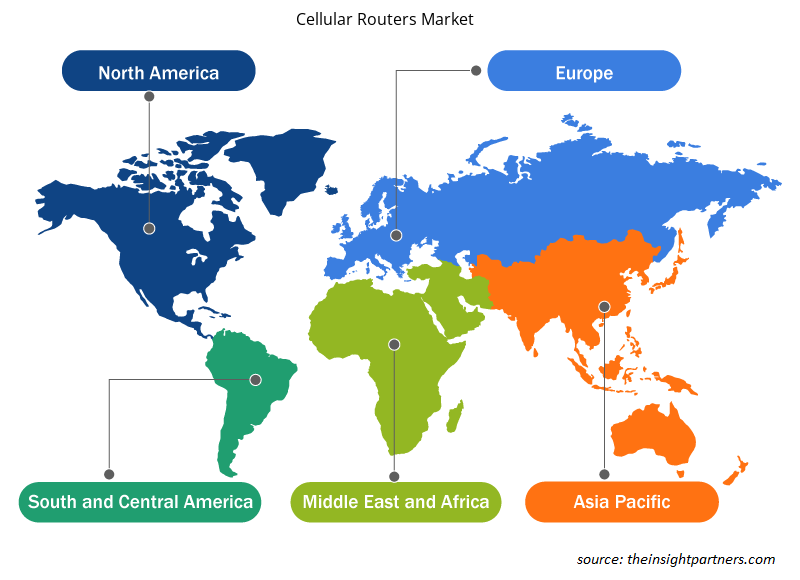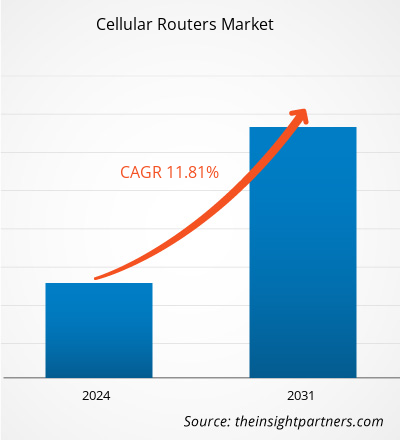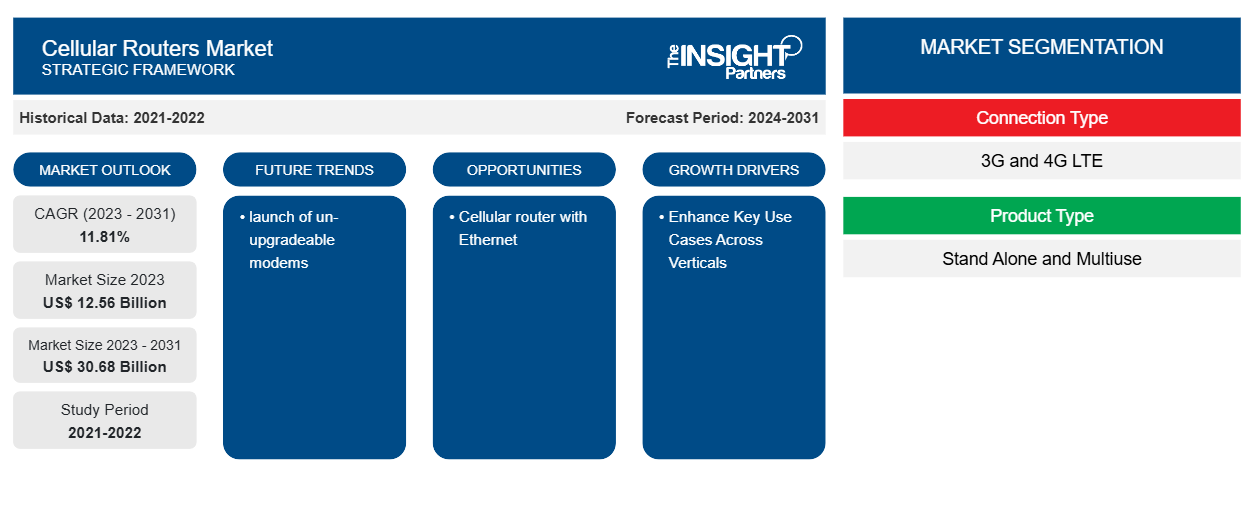Si prevede che il mercato dei router cellulari raggiungerà i 30,68 miliardi di dollari entro il 2031, rispetto ai 12,56 miliardi di dollari del 2023. Si prevede che il mercato registrerà un CAGR dell'11,81% nel 2023-2031. È probabile che il lancio di modem non aggiornabili rimanga una tendenza chiave nel mercato.CAGR of 11.81 % in 2023–2031. The launch of un-upgradeable modems is likely to remain a key trend in the market.
Analisi di mercato dei router cellulari
- Diversi aspetti significativi contribuiscono alla rapida espansione del mercato. L'implementazione globale dei modem cellulari 5G è guidata dalla crescente necessità di comunicazioni ad alta velocità e bassa latenza dovuta alla crescita della tecnologia SG in tutto il mondo.
- La connettività cellulare viene sempre più integrata in vari strumenti, come dispositivi IoT, gadget per la casa intelligente e apparecchiature industriali, stimolando la crescita del mercato.
Panoramica del mercato dei router cellulari
- I router cellulari impiegano la tecnologia cellulare per fornire connettività Internet. Sono un'opzione eccellente per aziende, famiglie e altri luoghi che non hanno accesso a servizi Internet cablati come cavo o fibra.
- Ciò rende i router cellulari uno strumento utile per le organizzazioni e gli individui che operano in località remote o che hanno bisogno di rimanere connessi mentre sono in viaggio.
- Presentano diverse qualità importanti che li rendono una scelta eccellente per l'informatica e la comunicazione mobile: connettività a velocità Gigabit; i router cellulari offrono connessioni veloci e affidabili con velocità fino a 5G e 4G LTE, consentendo un rapido accesso ai servizi di streaming e alle app web.
- Portabilità: i router cellulari sono dispositivi leggeri e piccoli, semplici da trasportare e configurare.
Personalizza questo report in base alle tue esigenze
Riceverai la personalizzazione gratuita di qualsiasi report, comprese parti di questo report, o analisi a livello nazionale, pacchetto dati Excel, oltre a usufruire di grandi offerte e sconti per start-up e università
-
Scopri le principali tendenze di mercato in questo rapporto.Questo campione GRATUITO includerà analisi di dati che spaziano dalle tendenze di mercato alle stime e alle previsioni.
Driver e opportunità del mercato dei router cellulari
Migliorare i casi d'uso chiave nei settori verticali per favorire il mercato
- Sebbene le reti Wi-Fi siano uno standard in molte aziende, i router cellulari stanno guadagnando popolarità in numerosi settori grazie alla loro capacità di fornire accesso ai dati wireless tramite reti cellulari.
- I router Wi-Fi stabiliscono una connessione di rete wireless tra due dispositivi, solitamente tramite onde radio, per fornire Wi-Fi ad alta velocità su brevi distanze. Il Wi-Fi è solitamente utilizzato per accedere a Internet tramite un router wireless collegato a una connessione cablata a banda larga.
- I router cellulari utilizzano torri cellulari per fornire connettività Internet wireless su lunghe distanze. Sono spesso utilizzati per connettersi a Internet tramite un telefono cellulare o un altro dispositivo mobile, ma possono anche supportare reti estese in aree rurali. Ciò li rende adatti a diversi casi d'uso principali in diversi settori: vendita al dettaglio, assistenza sanitaria, trasporti, produzione e altri.
Router cellulare con Ethernet
- Molti router trasmettono Internet in modalità wireless a tutti i dispositivi sulle loro reti wifi. Altre volte, potresti dover collegare il tuo dispositivo al router tramite un cavo Ethernet. Un cavo Ethernet è un cavo personalizzato che fornisce una connessione Internet cablata. Prima del wifi, tutte le connessioni Internet richiedevano un cavo Ethernet agganciato a una parete.wirelessly to all devices on their wifi networks. Other times, you may need to connect your device to the router using an Ethernet wire. An Ethernet cable is a customized cable that Provides a hardwired internet connection. Before wifi, all internet connections required an Ethernet wire hooked into a wall.
- Le connessioni Ethernet in genere offrono una connessione Internet più rapida e più costante rispetto al Wi-Fi. Tuttavia, sono scomode quando l'utente deve spostare fisicamente il gadget. La maggior parte dei telefoni e degli altri dispositivi mobili non dispone di connessioni via cavo Ethernet, quindi dovrai acquistare un adattatore per collegarli.wifi. However, they are inconvenient when the user needs to physically move the gadget. Most phones and other mobile devices lack Ethernet cable connections, so you'll need to purchase an adaptor to connect them.
Analisi della segmentazione del rapporto di mercato dei router cellulari
I segmenti chiave che hanno contribuito alla derivazione dell'analisi di mercato dei router cellulari sono il tipo di connessione, il tipo di impresa e l'utente finale.
- In base al tipo di connessione, il mercato è segmentato in 3G e 4G LTE.LTE.
- In base alla tipologia di prodotto, il mercato è segmentato in autonomo e multiuso.
- In base all'applicazione, il mercato è segmentato in vendita al dettaglio e commerciale, residenziale, industriale e trasporti.
Analisi della quota di mercato dei router cellulari per area geografica
- Il rapporto sul mercato dei router cellulari comprende un'analisi dettagliata di cinque principali regioni geografiche, che include le dimensioni attuali e storiche del mercato e le previsioni per il periodo 2021-2031, coprendo Nord America, Europa, Asia-Pacifico (APAC), Medio Oriente e Africa (MEA) e Sud e Centro America.APAC), Middle East and Africa (MEA), and South & Central America.
- Ogni regione è ulteriormente suddivisa in sottosegmenti nei rispettivi paesi. Questo rapporto fornisce analisi e previsioni di oltre 18 paesi, che coprono le dinamiche del mercato dei router cellulari, come driver, tendenze e opportunità che stanno influenzando i mercati a livello regionale.
- Il rapporto comprende inoltre l'analisi PEST, che prevede lo studio dei principali fattori che influenzano il mercato dei router cellulari in queste regioni.
Approfondimenti regionali sul mercato dei router cellulari
Le tendenze regionali e i fattori che influenzano il mercato dei router cellulari durante il periodo di previsione sono stati ampiamente spiegati dagli analisti di Insight Partners. Questa sezione discute anche i segmenti e la geografia del mercato dei router cellulari in Nord America, Europa, Asia Pacifico, Medio Oriente e Africa e America centrale e meridionale.

- Ottieni i dati specifici regionali per il mercato dei router cellulari
Ambito del rapporto di mercato sui router cellulari
| Attributo del report | Dettagli |
|---|---|
| Dimensioni del mercato nel 2023 | 12,56 miliardi di dollari USA |
| Dimensioni del mercato entro il 2031 | 30,68 miliardi di dollari USA |
| CAGR globale (2023-2031) | 11,81% |
| Dati storici | 2021-2022 |
| Periodo di previsione | 2024-2031 |
| Segmenti coperti |
Per tipo di connessione
|
| Regioni e Paesi coperti |
America del Nord
|
| Leader di mercato e profili aziendali chiave |
|
Densità dei player del mercato dei router cellulari: comprendere il suo impatto sulle dinamiche aziendali
Il mercato dei router cellulari sta crescendo rapidamente, spinto dalla crescente domanda degli utenti finali dovuta a fattori quali l'evoluzione delle preferenze dei consumatori, i progressi tecnologici e una maggiore consapevolezza dei vantaggi del prodotto. Con l'aumento della domanda, le aziende stanno ampliando le loro offerte, innovando per soddisfare le esigenze dei consumatori e capitalizzando sulle tendenze emergenti, il che alimenta ulteriormente la crescita del mercato.
La densità degli operatori di mercato si riferisce alla distribuzione di aziende o società che operano in un particolare mercato o settore. Indica quanti concorrenti (operatori di mercato) sono presenti in un dato spazio di mercato in relazione alle sue dimensioni o al valore di mercato totale.
Le principali aziende che operano nel mercato dei router cellulari sono:
- Azienda
- Sierra Wireless, Inc.
- Digi International, Inc.
- Società: Advantech
- Moxa Inc
- Belden, Inc
Disclaimer : le aziende elencate sopra non sono classificate secondo un ordine particolare.

- Ottieni una panoramica dei principali attori del mercato dei router cellulari
Notizie di mercato e sviluppi recenti sui router cellulari
Il mercato dei router cellulari viene valutato raccogliendo dati qualitativi e quantitativi dopo la ricerca primaria e secondaria, che include importanti pubblicazioni aziendali, dati di associazioni e database. Di seguito sono elencati alcuni degli sviluppi nel mercato dei router cellulari:
- D-Link, pioniere globale nella tecnologia di rete e connessione, ha presentato il router intelligente R15 EAGLE PRO AI AX1500. Il nuovissimo router R15 EAGLE PRO AI combina la più recente tecnologia wifi 6 con l'intelligenza artificiale per fornire una copertura e una velocità wifi eccezionali. (Fonte: D-Link, comunicati stampa, dicembre 2021)
- Proscend ha lanciato un router cellulare outdoor per colmare il divario digitale. Proscend Outdoor 4G LTE Cellular Router M366 è progettato per soluzioni Fixed Wireless Access (FWA) convenienti, facili da implementare e flessibili. Con la matura copertura di rete 4G, Proscend M366 avvantaggia non solo le famiglie che vivono in aree non servite e sottoservite in cui l'infrastruttura cablata non è raggiungibile. (Fonte: Proscend, comunicati stampa, aprile 2022)
Copertura e risultati del rapporto sul mercato dei router cellulari
Il rapporto "Dimensioni e previsioni del mercato dei router cellulari (2021-2031)" fornisce un'analisi dettagliata del mercato che copre le seguenti aree:
- Dimensioni e previsioni del mercato dei router cellulari a livello globale, regionale e nazionale per tutti i segmenti di mercato chiave coperti dall'ambito
- Tendenze del mercato dei router cellulari, nonché dinamiche di mercato quali driver, limitazioni e opportunità chiave
- Analisi dettagliata delle cinque forze PEST/Porter e SWOT
- Analisi di mercato dei router cellulari che copre le principali tendenze del mercato, il quadro globale e regionale, i principali attori, le normative e i recenti sviluppi del mercato
- Analisi del panorama industriale e della concorrenza che copre la concentrazione del mercato, l'analisi della mappa di calore, i principali attori e gli sviluppi recenti nel mercato dei router cellulari
- Profili aziendali dettagliati
- Analisi storica (2 anni), anno base, previsione (7 anni) con CAGR
- Analisi PEST e SWOT
- Valore/volume delle dimensioni del mercato - Globale, Regionale, Nazionale
- Industria e panorama competitivo
- Set di dati Excel
Report recenti
Rapporti correlati
Testimonianze
Motivo dell'acquisto
- Processo decisionale informato
- Comprensione delle dinamiche di mercato
- Analisi competitiva
- Analisi dei clienti
- Previsioni di mercato
- Mitigazione del rischio
- Pianificazione strategica
- Giustificazione degli investimenti
- Identificazione dei mercati emergenti
- Miglioramento delle strategie di marketing
- Aumento dell'efficienza operativa
- Allineamento alle tendenze normative























 Ottieni un campione gratuito per - Mercato dei router cellulari
Ottieni un campione gratuito per - Mercato dei router cellulari